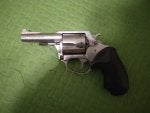any feed back on these carry handguns? quality? comfort? thanks

www.thehighroad.org
The very first Charter Arms Corporation production began in 1964 in BRIDGEPORT CONN - earliest pieces - mostly Undercover model will have either NO address on the right side of the barrel or will have BRIDGEPORT.
Around 1970, address was changed to STRATFORD CONN - all pieces made after mid 1970 will be marked with that address on the right side of the barrel and all will have CHARTER ARMS CORP. as the first line. Around 1991, Charter Arms Corp. ceased operations. This was the end of the FIRST GENERATION.
Around early 1992, the company was re-organized under new leadership and became known as Charter Arms Company - CHARCO, and was located in ANSONIA CONN. All second generation pieces will be marked on the right side of the barrel with that name and address in two lines. This is the SECOND generation and apparently the period which caused the most damage to the Charter name and reputation.
In 2000, the company was again reorganized as CHARTER 2000 and relocated to SHELTON CONN. All pieces made during this THIRD generation will be marked with the SHELTON address. Early production of this generation seems to have been spotty and reputation still lagged.
About a year and a half ago, the company re-reorganized under the direction of MKS Marketing and seems now to be if not flourishing at least it is progressing in quality and market share.
From the limited data set that I have been able to assemble so far the following serialization seems to be valid: (NOTE: model name and caliber will be stamped on left side of barrel on all pieces)
The earliest 1st Gen - ~0 to ~19,000 have NO barrel ADDRESS and s/n is on lower right corner on right side of frame. CA company founded in 1964, first production pieces of the Undercover model produced in 1965
Bridgeport CONN address - ~19000 to ~315,000 1967 - 1973
Stratford CONN address - ~316000 to ~1,090,000 1974 - ~1991
All marked as Charter Arms Corporation
2nd Generation - CHARCO, Ansonia Conn adress - 1,090,000 to ??? ~1991 - 1999
3rd Generation - CHARTER 2000 - Shelton Conn - 0 to where ever they are today.
I know for a fact that CA serial number 500,000 was reached on Sept. 30th 1979.
I purchased my blue 3" Bulldog .44Spl in early 1980, NIB serial number 713xxx.
As I recall, I had a difficult time obtaining one because at the time the Charter Arms Bulldog .44Spl was in high demand by the LE community for use as a BUG. I ended up ordering mine from a local gun shop and waiting about a month for it to show up. I would place the manufacture date somewhere between November, 1979 - January, 1980. Hopefully this info will shed some light on where they were Serial Number wise back in the late 1979 to early 1980 time frame.
An older one. Has the Bridgeport address. Serial 241XXX
From the 26 pieces in my collection (all 1st Gen) and from dozens more that I've had the opportunity to observed and fondle, I'd say that around s/n 600,000 the finish was made a lot finer - although the integrals (lock work, action) was at least as good as the earlier ones. I have or have read magazine articles that cover pretty much of the production life of the 1st Generation, and during that period (around late 1980, early 1981) it seems that CA attempted to capture more of the market by doing so, also in April of 1981, they introduced Stainless Steel revolvers into the mix, for the first time.
First Generation Charter Arms revolvers: will have Bridgeport or Stratford CONN. barrel addresses, s/n under 1,100,000 - are no worse and in many cases better than most revolvers built between 1966 and 1991 (the era of production of the 1st Gen.) The designer and founder, Doug McClennahan worked as a design engineer for Colt, High Standard and Ruger before he went out and founded Charter Arms - hence many of the features and strengths found in those three highly respected firearms are found in the 1st Gen. CA revolvers. The frames, barrels and cylinder are chrome-moly steel for blued pieces and 400 series for the Stainless steel verision - all blued models had an aircraft grade, anodized aluminum, machined grip frame, the stainless models have a stainless steel grip frame. All models have 8 groove rifling (vs. 6 for S&W, Colt and Ruger), coil main spring, beryllium-copper spring mounted unbreakable firing pins, patented safety transfer bar ignition (copied by Ruger),
Some of the articles lamented that the earlier pieces, although rough finish, were rather inexpensive (~60-65% of S&W) and when CA began their "modernization" process, the finishes got better but the prices increased to about 85 to 90% of the S&W line for comparable models.
During the 2nd Generation, the CHARCO (Charter Arms COMPANY), under new management and reorganized, the quality was definitely more spotty and haphazard. I've seen CHARCO produced guns with Stratford marked barrels, obviously using up old stock.
The earliest CHARTER 2000 pieces I had the opportunity to handle (some fairly early 4 digits s/ns - were uniformly, poorly fitted and finished and had some horrendous and gritty actions. That seems to have been rectified under MKS's (circa 2008) new leadership and the most recent pieces I've handled - s/n's in the high 100,000 range have been "decent" but not as fine in finish and action as the mid years of the 1st Generation.









